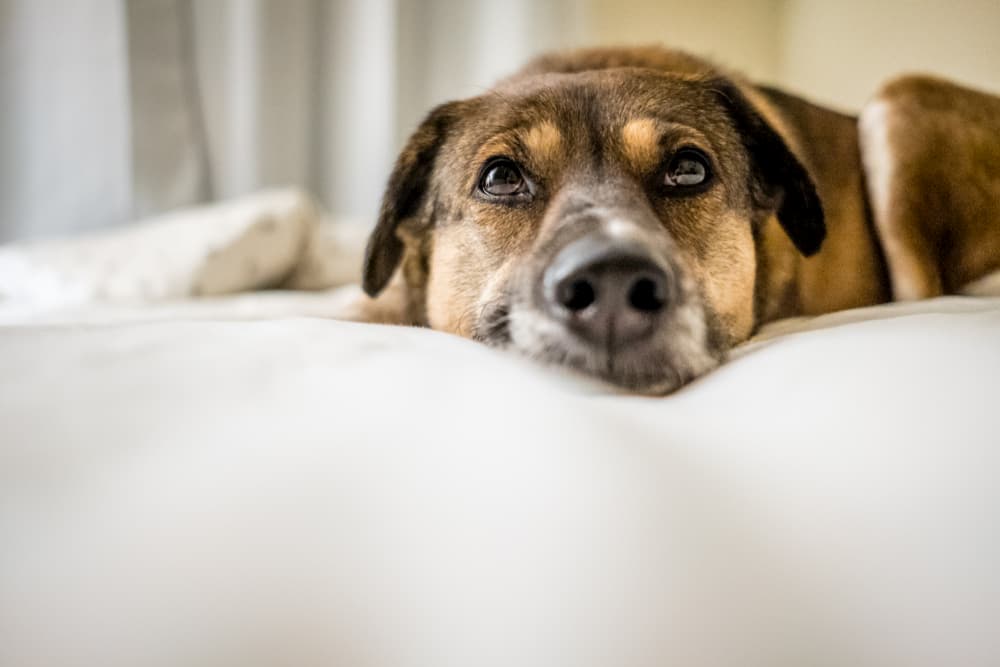Dog Eyelids: Facts and Common Problems

As dog parents most of us spend a lot of time gazing into our furry companions’ eyes. After all, the eyes are the gateway to the soul, right? Well, if the eyes are the gateway then the eyelids are the gatekeepers.
Many of us don’t give a whole lot of thought to our own eyelids, much less our dog’s eyelids. However, a dog’s eyelids serve important functions, and when something goes wrong it can negatively impact a dog’s vision.
Do Dogs Have Eyelids?

All dogs do, in fact, have eyelids. But depending on your dog’s breed, they may not be as pronounced as your own eyelids. Just like in humans, a dog’s eyelids are an extension of the skin. They protect the eyes and keep them healthy.
How Many Eyelids Do Dogs Have?
Here is where dogs and humans differ. Dogs have three eyelids while humans only have two functional eyelids.
A dog’s third eyelid—also called the nictitating membrane—is usually hidden, with only a small portion normally visible. If you look closely into your dog’s eyes, you will see a small triangular segment of his third eyelid at the inner corner of his eyes. The third eyelid is typically black, brown, or (rarely) pink.
The Purpose of Dog Eyelids

Eyelids serve multiple important functions to protect your dog’s eyes. These include:
Protecting your dog’s eyes. Due to the blink reflex, if an object comes near a dog’s eyes, his eyelids will close and prevent the eye from trauma.
Keeping your dog’s eyes lubricated. Eyelids also help to keep dogs’ eyes moist with tears. Every time your dog blinks, the eyelids stimulate more tears to come out and old tears to drain away.
Tear production. A dog’s third eyelid is also responsible for producing tears. Tears contain liquid to keep the eyes lubricated, but they also contain important proteins called immunoglobulins which are part of the immune system’s defense in protecting the eyes from infections.
Dog Eyelid Problems

Abnormalities and diseases affecting the eyelids are fairly common in dogs. The following symptoms can signal an issue with your dog’s eyelids:
- Excessive tearing
- Lumps/bumps
- Redness
- Swelling
- Squinting
- Changes in color
Common dog eyelid problems include:
Entropion
Entropion is a condition in which part or parts of a dog’s eyelids roll inwards. This causes the outer-haired portion of the eyelids to contact the surface of the eye and leads to irritation. Entropion often causes excessive tearing, eye redness and squinting. The condition makes dogs more prone to corneal ulcers, corneal scarring and dry eye.
Most of the time entropion is due to abnormal eyelid shape and commonly occurs in many breeds including English Bulldogs, Labradors, and Golden Retrievers. Sometimes entropion may be temporary when it is caused by eyelid muscle spasms due to some other painful eye condition.
Treatment for entropion involves surgery in breed-related cases and treating the underlying eye condition in cases of spastic entropion.
Ectropion

Ectropion is the opposite of entropion, where a dog’s eyelids turn inside-out. It looks like a dog’s eyelids are sagging.
Some breeds, such as the Cocker Spaniel and Basset Hound have ectropion as part of their breed standard conformation. Ectropion may also be secondary to trauma of the eyelid or previous eyelid surgery. While it’s not as dangerous as entropion, this condition may cause dry eye, keratitis (inflammation of the cornea) or conjunctivitis (“pink eye”).
When necessary, surgery is performed to correct this condition.
Blepharitis
Blepharitis means inflammation of the eyelids and it has many different causes in dogs. Blepharitis will cause red, puffy, and often itchy eyelids. Hair loss around the eyelids may occur as well. Styes, or a small bump or bumps in the eyelid, are due to infection of the eyelid glands and are typically treated with warm compresses, as well as topical and sometimes oral antibiotics.
Allergic skin disease is another common cause of blepharitis. Dogs with blepharitis due to allergies will often have signs of inflammation or itchiness on other parts of their bodies. Environmental, food, and contact allergies may be responsible. While allergies are not curable, they can be managed with different medications, foods and/or supplements.
Parasites can also cause blepharitis. The demodex and scabies mites as well as the fungus that causes ringworm can all affect the eyelids of dogs. Oral medications are typically needed to treat these parasites.
Color Changes to the Eyelids

Some dogs may develop black spots around their eyes as they age. Sometimes this may not be concerning if the spots are not raised and not crusted. However, any changes in the color of your dog’s eyelids should prompt a trip to your veterinarian, as dogs can develop melanoma or other cancers of their eyelids.
Eyelid Growths
Dogs may develop growths or tumors on the margins, or edges, of their eyelids. Depending on the color, shape, and appearance of the growth, your veterinarian may have a good idea if the tumor appears cancerous or not.
However, the only way to know for sure whether or not a growth is or isn’t a concern is to have it tested either by removing the entire thing or a portion of the growth. If an eyelid margin tumor is rubbing your dog’s eye, it can cause pain and other issues and should be surgically removed.
Cherry Eye
A “cherry eye” in dogs is caused by a prolapse or protrusion of the third eyelid gland. This causes there to be a red mass at the inner corner or one or both eyes. A cherry eye commonly occurs in young dogs, and brachycephalic breeds (breeds with shortened snouts including Bulldogs, Boxers, and Boston Terriers) are at an increased risk.
Most of the time a cherry eye requires surgery to treat. The surgery does have a high risk of failure so it should be performed either by a veterinary ophthalmologist or by a general veterinarian that is well trained in this procedure.
How to Care For Your Dog’s Eyelids

Unless your dog has an issue with his eyes or eyelids, it is best to leave the eyelids alone. Brachycephalic breeds and any dogs with allergies are more prone to developing eyelid irritation and may benefit from having their eyelids wiped clean on a regular basis.
Never use soap or other chemicals near your dog’s eyes, as the products can damage the eyes. Just use water and a cotton ball or soft gauze to gently wipe your dog’s eyelids.
If you notice any abnormalities with your dog’s eyelids, such as swelling, redness, hair loss, discharge, growths, or color changes, it is important to have your dog evaluated by a veterinarian.









